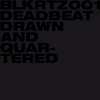[BLKRTZ]
Dub music has gone through a revitalization of sorts in recent years. The popularity of dubstep may have had something to do with it, but except for a small set of producers making a particular strain, the differences can be as far apart as the echoes that pervade dub. Horsepower Productions carry the flame and Pinch’s Tectonic label is very obviously influenced by Scientist and other classic dub manipulators. However, to find true and innovative dub, one need look no further than the 12-year career of Scott Monteith, aka Deadbeat. In over a half dozen albums for such labels as ~Scape and Wagon Repair, he has carved out a varied, respectful and exciting path that includes tape delay, spacious low end, and warm chords. His latest album for BLKRTZ, Drawn & Quartered, is a sometimes dark, sometimes effortlessly beautiful foray into deep rhythms and floating synthesis.
One of the most compelling aspects of Drawn & Quartered is the use of granular synthesis and field recordings to construct the melodies and textures. It’s particularly exciting and unexpected when combined with dub rhythm patterns. “First Quarter” is an excellent example of this, with an extended prelude of metallic feedback and modular experiments, calling to mind Justin Broadrick’s Final project or Fennesz’s guitar experiments. Here, though, the edgy ambience gives way to a deep bass drop and rumbling beat that echoes for 10 minutes of dub bliss. Following this with the more restrained “Second Quarter” is an interesting choice, as it mostly eschews the experimental side for a more typical techno rhythm.
A name that keeps percolating in my ears when listening to Drawn & Quartered is The Orb. While that older group had a penchant for humor and irreverence in their dub-laden house rhythms, Deadbeat is more focused on emotion and atmosphere, but similarly innovative thinking runs through both of their work. As “Second Quarter” and “Fourth Quarter (Cala’s House)” show, Deadbeat is also a fan of house rhythms and how they can interact with the effects and techniques of classic dub. For both outfits, though, the more experimental and unique compositions proved to be the most interesting. “Third Quarter (The Vampire of Mumbai)” is a good example, with crackling electronics made from granular synthesis and field recordings that provide a slow ascent towards an equally slow rhythm in the most subtle of ways. Featuring live horns from David Koch as well as live bass and conga, the vibrant song feels full of life, a fully organic display of modern dub.
Deadbeat comes to rest at “Plateau Quarter (Hope in Numbers),” which is ostensibly a tribute to Montreal but also a cinematically paced closer, like Blade Runner and Heat crossed with Lee “Scratch” Perry in a way that doesn’t shy away from dub’s companion, reggae. This track begin at a pensive space but quickly morphs into a lively celebration. One can imagine the string-laden opening to be reflecting dawn in Montreal, with the energy that follows representing a day’s exploration. Whether it is through experimental synthesis, house rhythms, floating ambience or monumental bass, Deadbeat proves himself to be worthy of dub’s legacy even as he toys with its conventions.

















Fantastic album, unfortunatly also the victim of the neverending trend of releasing on vinyl without being complete.